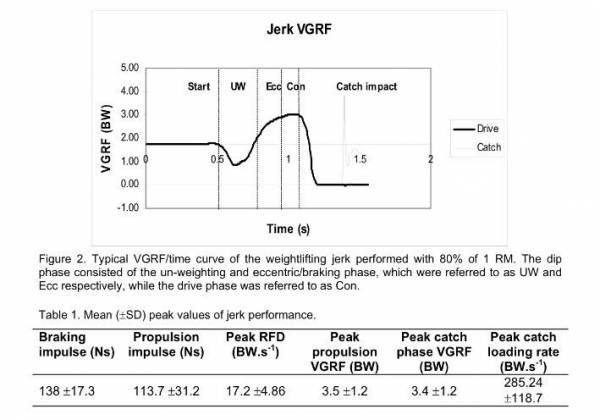Photo by Bruce Klemens
Photo by Bruce Klemens
Interestingly enough, not many studies have investigated the impact of explosive overhead pressing movements – push pressing, push jerking and split jerking, for example – on performance in sports. More than 20 years have gone since Garhammer’s last publication in merit on propulsion forces as a function of intensity for weightlifting and vertical jumping in the Journal of Applied Sports Research.
Dr. Garhammer found reasons to consider the hang power clean and the split jerk as different exercises, with different applications in the strength and conditioning field. The weightlifting jerk “happens” to be part of a more complex event, the clean & jerk: these movements, however, display different biomechanical features which, in turn, suggest different applications for athletic development.

Ideally snatch, clean and jerk could be aligned in this particular order along a continuum that goes from high-velocity/low-force movements to low-velocity/high force movements as indicated by the different kinetic and kinematic profile of these exercises: the jerk, on the left-hand side of the Hill’s curve, displays what Dr. Garhammer called a U-shape profile whereas the snatch, the clean and any other athletic-like movement (such as the vertical jump) display what appears to be a V-shape profile and they heavily spread across the middle/right-hand side of the hyperbole.
The overhead pressing mechanics involved in the weightlifting jerk allows for peak power output to be achieved with a much higher load than any other Olympic weightlifting movement although the rate of force development (RFD) displays a less “sharp” peak resulting in a smooth, U-shape slope.
These basic considerations suggest how the jerk and its variations – the overhead press, the push press and the split jerk – should be considered more like a strength-oriented movement rather than like a power-orientated movement: they provide excellent axial load, developing lower and upper body maximal strength while challenging coordination, balance and active range of motion. Paraphrasing Dr. Yuri Verkhoshansky, the weightlifting jerk develops “strength in presence of speed”, the stereotypical definition of “functional strength” as it applies across the board in every sporting event that requires a different combination of strength, speed, and power.
Reference:
1. Garhammer, J., & Gregor, R. (1992). Propulsion forces as a function of intensity for weightlifting and vertical jumping. J Appl Sport Sci Res, 6(3), 129-34.
2. Lake, Jason, Mike Lauder, and Rosemary Dyson. “Exploring the biomechanical characteristics of the weightlifting jerk.” ISBS – Conference Proceedings Archive 1, no. 1 (November 2, 2007).






